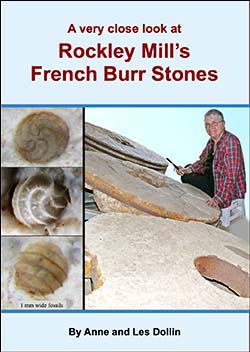
The History of Millstones:
Milling Flour with Solid Stone
Including: French Burr Stone, Millstone Grit, Cullin Stone, granite, limestone, sandstone
Singleton Mills homepage > Overview of millstones – and the best stone types to make them.
Using solid stone to mill flour
For over 10,000 years, people across the world have been cutting and shaping pieces of stone into milling stones to grind wheat into flour. From the earliest times, small portable hand-milling stones called 'Querns' were used; then later, massive 'Millstones' were cut for use in powered flour mills.
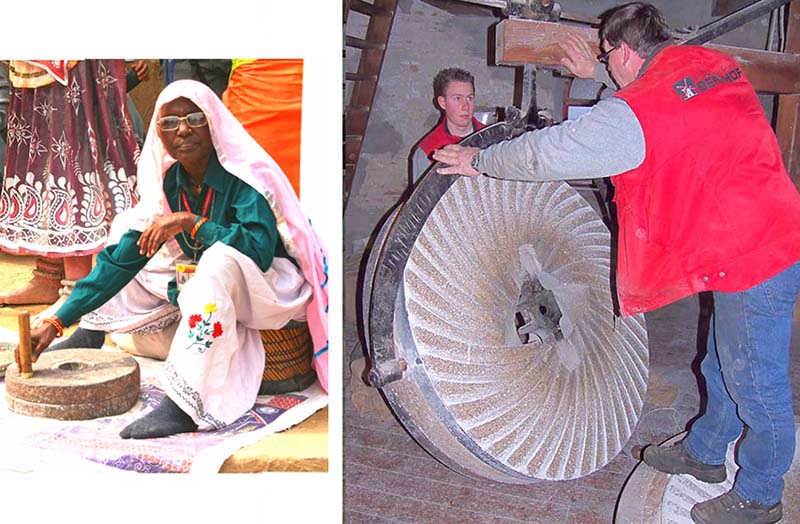
Above left, a woman in India holds the handle of a pair of small quern stones used for grinding grain by hand. Above right, a man positions a full-sized millstone in a large-scale flour mill, whilst standing on the second millstone of the pair. Both images are from Wikimedia Commons: left, by Ramesh Lalwani; right, by Rasbak.
Certain special stone types became prized for their milling qualities, and extensive millstone quarries developed where these deposits were found. Unfinished milling stones still can be seen in abandoned quarries around the world.
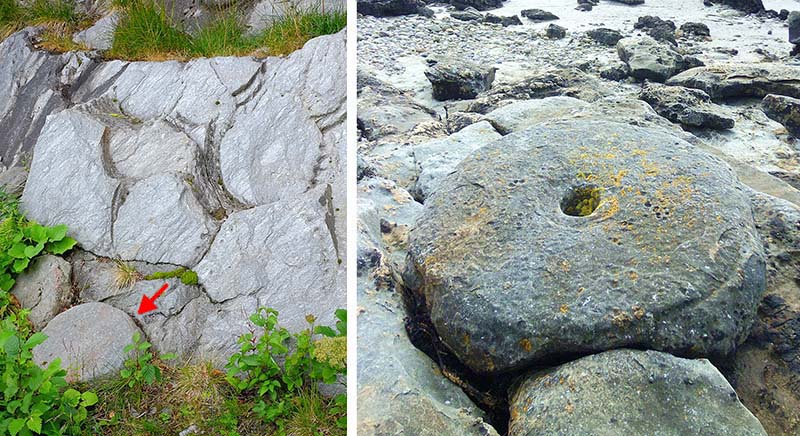
Above left, a small unfinished quern stone (see red arrow) and traces of partially carved querns in the remaining cliff face, in a quern quarry in Norway. Above right, an unfinished full-sized millstone in a quarry area in Scotland, UK. Both images from Wikimedia Commons. Left, photograph by Frankemann; right, photograph by Gordon Hatton.
Read More About the Different Types of Millstones
•• French Burr Stones •• Basalt-like Cullin Stones •• Millstone Grit •• Old Red Sandstone, Puddingstone, and Lodswoth Stone •• Granite •• Limestone •• Artificial Millstones •• Colonial Millstones ••
New research on Australian French Burr Stones ... and their amazing 30 million year old fossils! |
What are millstones?
Millstones (or grinding stonesA) are large disks of stone used to grind wheat, corn, rye, oats, barley, and other grains, in a flour mill or a grist mill.B Initially the millstones were driven by animals or man-power. Later it was discovered how to harness the power of flowing water or the wind to drive the millstones.
Each millstone had a large central hole. Two millstones were mounted face to face, and grain was fed in through the central hole. The lower stone, known as the 'bed stone' or 'nether stone', was stationary. The upper stone, or 'runner stone', rotated when it was connected to a power source. The grain was ground into flour between the almost-touching surfaces of the two millstones.
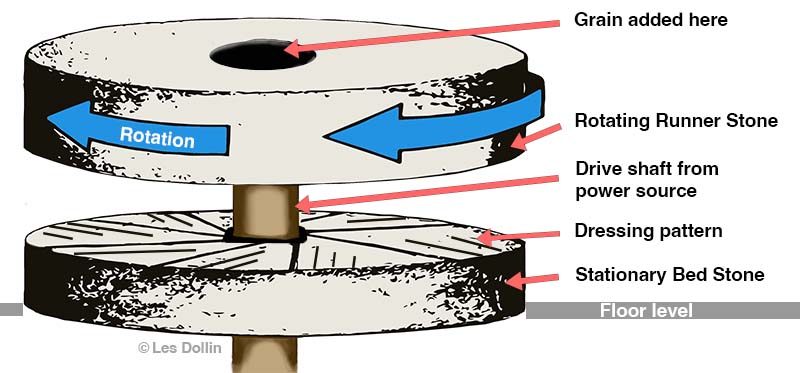
Above, a very simplified diagram showing the arrangement of the two millstones in a flour mill. In this diagram, the two stones are shown separated from one another, so that the mechanism driving the upper stone can be seen. However, when the millstones are in use, the upper stone is lowered towards the lower stone until their surfaces almost touch. In addition, the two stones are enclosed in a wooden case or 'tun' which collects the ground flour. Diagram by Les Dollin.
As flour milling technology advanced, powered mills using pairs of increasingly large millstones were developed. The more advanced versions of these mills used pairs of very large, heavy millstones. In Britain, millstones ranged in size from about 0.8 – 1.6m (2.7 to 5.5 feet) in diameter, and a typical Peak District millstone weighed, when newly cut, about 2.5 tonnes.[1, 2]
A: Grinding stones or grindstones. The term 'grind stone' may refer to a millstone that is used to grind grain. However, more commonly, it refers to an individual stone used to sharpen steel tools. Read more about Grindstones.
B: Millstones used for other purposes. Millstones, mounted vertically, were also used in other industries. The smooth edges and heavy weight of rolling millstones were used to crush a variety of materials including olives, apples, and gun powder.
Millstone dressing patterns
Intricate dressing patterns were painstakingly carved by hand onto the grinding surfaces of millstones:
– These patterns improved the way that the stones sheared open the cereal grains. As the upper millstone rotated against the face of the lower stone, the grooves in their dressing patterns sheared the grains open with a scissor-like action.
– The dressing patterns helped transport the milled flour towards the edge of the millstone.
– The grooves also provided ventilation between the stones, which helped reduce the build-up of heat during grinding.
Many different millstone dressing patterns were used in different regions of the world.
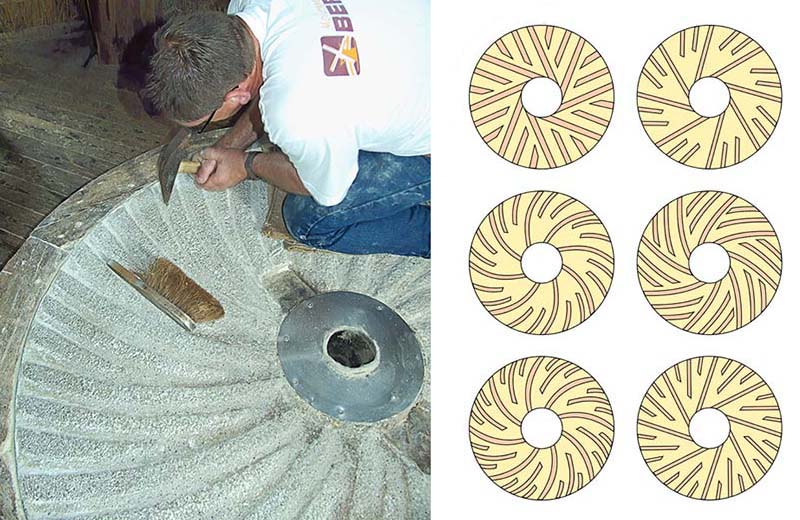
Above left, an artisan chips a dressing pattern by hand onto the grinding surface of this millstone. Above right, some of the many millstone dressing patterns that have been used throughout the world. Both images adapted from documents in Wikimedia Commons. Left, photograph by Rasbak; right, diagrams by MOOtty.
A close look at a dressing pattern
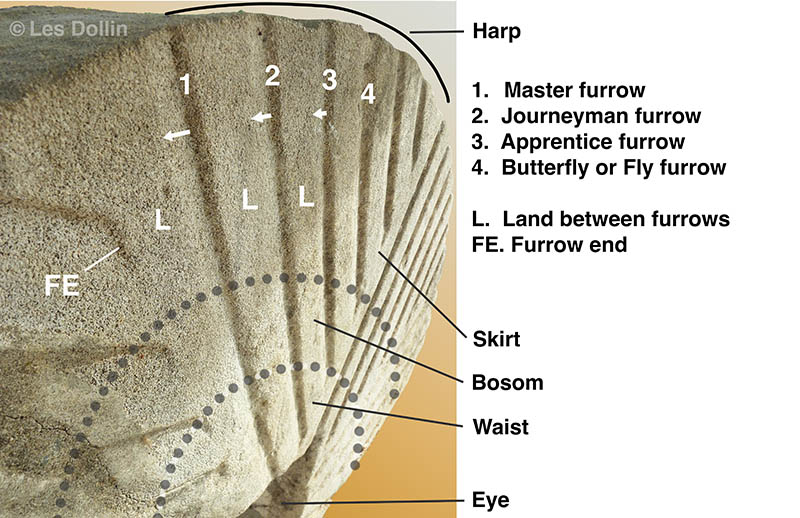
Above, a close-up view of the dressing pattern on one of the old millstones from the Kurrajong Singleton watermills. Details given below. Photograph and graphic by Les Dollin.
The graphic above shows detail of the dressing pattern on one of the Singleton Family millstones displayed at Memorial Park, Kurrajong Village, NSW. The dressing pattern is divided into sectors (each known as a 'Harp' or a 'Quarter'). The Harp shown here contains six furrows. The names given to the first four furrows in each Harp are: 'Master', 'Journeyman', 'Apprentice' (or 'Prentice'), and 'Butterfly' (or 'Fly'), as indicated on the graphic.
The flat stone area between each of the furrows is called the 'Land'. When dressing one of the highly-prized French Burr Stones, the Millwright would cut additional minute rows of parallel lines across all areas of the Land, using an iron pick. A skilled millwright could cut up to 30 rows of lines per inch (2.5 cm) across the Land surface. These tiny cuts were called 'Cracking' or 'Stitching' and they improved the grinding ability of the French Burr Stones.
Each furrow began with a deep cut into the stone, which was then tapered off, in one direction only, towards a 'Feather edge' at the level of the Land. The direction of the taper in three of the furrows is indicated with the white arrows, and can be seen by closely inspecting the millstone image in the above graphic. Each furrow ends with a neat diagonal tapered cut, indicated on the graphic as 'FE'.
The hole in the centre of the millstone is called the 'Eye'. The Eye in this stone is square because this millstone was used as a lower stone or 'Bed Stone' in the watermill. During grinding, it was placed face-to-face with a similarly-dressed top stone or 'Runner Stone' – see diagram, above, showing the arrangement of the paired millstones.
The dressed surface of the millstone is divided into three zones:
– the central 'Waist',
– the 'Bosom' or 'Breast', and
– the outer 'Skirt'.
The stone surface in the Waist zone is slightly dished, to provide greater space between the millstones for the freshly added wheat grains. The clearance between the stones reduces across the Bosom and into the Skirt area – the Skirt areas of the two facing millstones nearly touch one another, and perform the finest grinding of the flour.
Best stone types for millstones
Through centuries of trial and error, the following stone types in Britain and Europe were found to be particularly good for making millstones:
•• Millstone Grit •• Old Red Sandstone •• Puddingstone •• Basalt •• Chert ••
The basalt and chert millstones of Europe performed so well that they were imported in huge numbers into Britain:
– The basalt stones, known as 'Cullin Stones' or 'Cullen Stones', were imported from Germany; and
– The chert stones, known as 'French Burr Stones', were imported from France.
In Britain, certain types of hard, high-silica, sandstone and conglomerate stones were quarried extensively for millstones. These included Millstone Grit, Old Red Sandstone and Puddingstone.
Other stone types that were also used, to lesser extents, for querns and millstones included Granite and Limestone.
Artificial Composite Millstones began to be manufactured at the end of the 1800s. Cast in a mould, these were made from cemented grains of materials such as Emery, slag, or granulated French Burr Stone.
Follow the links above |
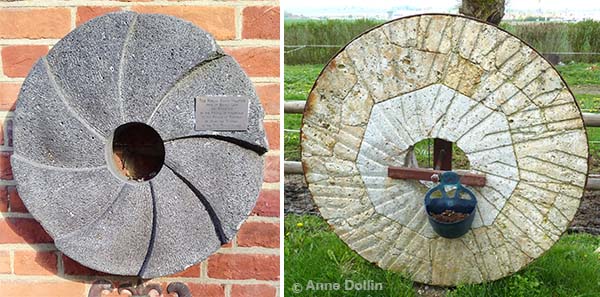
Above left, a small-scale basalt Cullen stone made at Andernach, Germany as a commemorative gift. Above right, a French Burr Millstone on display at the Steenmeulen Windmill in France. Photograph sources: left, Mertbiol, Wikimedia Commons; right, Anne Dollin.
WHY IS THE STONE TYPE USED FOR A MILLSTONE SO IMPORTANT? Commentary by Les Dollin: The type of stone that is chosen to make a millstone was of crucial importance to the mill owner. Flour mills were costly to build and often faced great competition from other mills. So, it was vital to keep your mill operating as continuously as possible. During harvest times, massive quantities of grain were brought to the mills for grinding, and, if a mill was out of operation, the grain might be taken to the next mill instead. The millstones were one of the most expensive components of a flour mill. They were costly and time-consuming to replace or repair if they failed. The reasons why a millstone might fail include: – It had a structural fault that caused it to break or shatter when it was being spun at the high speeds used during the milling process. The process of grinding grain also generated a great deal of heat, and this could also make millstones crack and break. – Its grinding surface wore out too quickly as the grain was ground. If the surface of the millstone wore down too quickly, it would have to be removed from service until a specialist millwright could come and re-dress the surface. So, millstones could not be successfully made from just any local stone source. Instead, millstones cut from specific stone types had to be obtained, for the flour mill to be economically viable. Unfortunately, as discussed in some detail on this website, when British settlers first came to Australia in the late 1700s and early 1800s, they were largely cut off from their preferred millstone types, because supplies of imported millstones were scarce. So, settlers strove to find local substitutes, known as Colonial Millstones with varying degrees of success. |
More detail about the mineral structure of the best stone types
Querns and millstones were quarried from similar types of stone. The stone needed to be tough and durable, so that it could break open the hard wheat grains and extract the starchy flour within.
The prominent British millstone historian, David Gordon Tucker, explained in 1987:
'The rock from which millstones were made had to be carefully chosen to meet exacting requirements, and sources of suitable rock were comparatively rare.' [3]
Desirable stone qualities for full-sized millstones:
– The stone needed to be free of faults or structural defects so that the millstone would stay in one piece and not shatter when subjected to the great pressure of grinding grain in a flour mill.
– The dressing process must produce numerous tiny sharp edges right across the grinding surface of the millstone. The presence of small quartz pebbles in the stone was helpful because quartz is extremely hard and has a sharp edge when broken open.[4]
– The millstone material had to be hard enough that its grinding surface would not wear rapidly. The best stones needed to be re-dressed less frequently (see 'Dressing Millstone Patterns', above).
A review on the Mills Archive describes the best type of stone as that with:
– 'a well-cemented matrix of fine to medium grains which gives a naturally hard-wearing and abrasive surface',
OR
– 'a vesicular texture [full of small holes] which provides continuous cutting edges even as it wears'.[5]
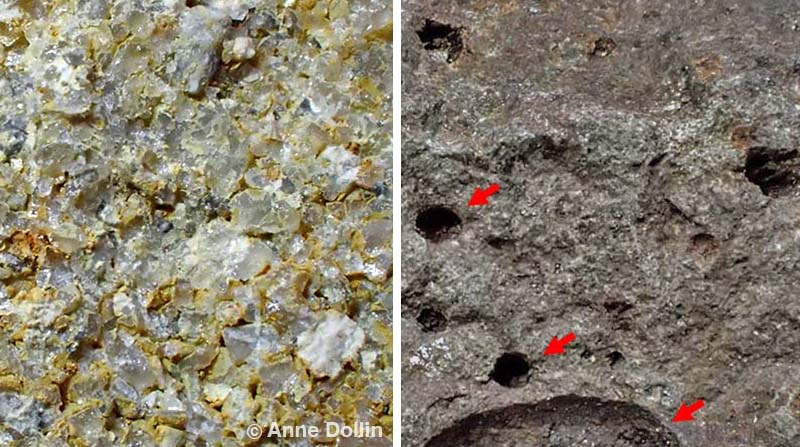
Above, two different types of stone that have good milling properties:
Left, Millstone Grit has dense, interlocking, well-cemented, abrasive grains;
Right, Vesicular Basalt contains numerous small holes (see red arrows), that were formed by gas bubbles that were trapped as the stone solidified. Similarly, the Chert of French Burr Stones naturally contains numerous tiny holes, some related to fossils within the stone. Macro images by Anne Dollin.
REFERENCES
1. Hockensmith, Charles D (2009) The Millstone Industry. McFarland and Company, Inc, Publishers, page 165.
2. Peakscan website.
3. Tucker, D Gordon (1987) Millstone making in England. Industrial Archaeology Review, IX (2): 167-188, page 167.
4. Tucker, DG (1977) Millstones, quarries, and millstone-makers. Post-Medieval Archaeology, 11: 1-21, pages 3-4.
5. From Quern to Computer.
Read More About Millstones
•• French Burr Stones •• Basalt-like Cullin Stones •• Millstone Grit •• Old Red Sandstone, Puddingstone, and Lodswoth Stone •• Granite •• Limestone •• Artificial Millstones •• Norfolk Island Millstones •• Colonial Millstones ••
